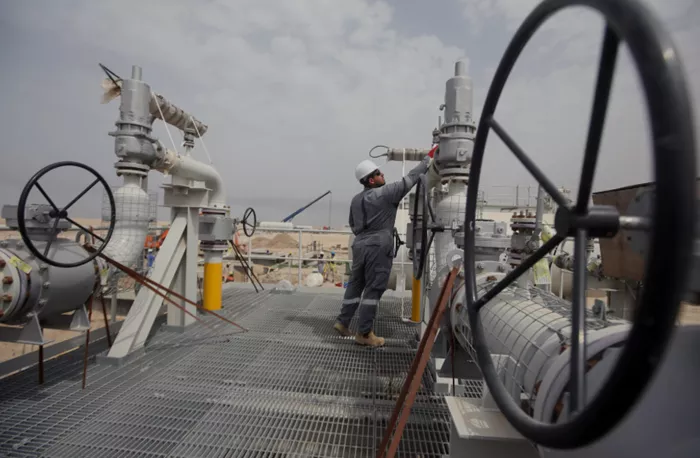China is tightening its grip on Iraq’s oil and gas sector, with the latest strategic contract reinforcing its growing dominance. The Iraq Oil Ministry’s renewed commitment to raising national crude production to 7 million barrels per day (bpd) within five years has invigorated Chinese firms, which already hold significant sway over the country’s energy resources.
According to industry data, Chinese companies currently control over one-third of Iraq’s proven oil and gas reserves and produce more than two-thirds of its output. This equates to a direct stake in roughly 24 billion barrels of reserves and responsibility for producing approximately 3 million bpd.
The newest beneficiary of this surge is China Huanqiu Contracting & Engineering Company (HQC), a subsidiary of China National Petroleum Corporation (CNPC). HQC has secured a high-profile project management consultancy contract for the West Qurna 1 oilfield, one of the world’s largest oil assets. CNPC had earlier replaced ExxonMobil as the field’s lead operator.
Located roughly 65 kilometers from Basra, West Qurna 1 holds a significant portion of the estimated 43 billion barrels in the greater West Qurna complex. Originally thought to contain 9 billion barrels, its recoverable reserves were upgraded by Iraq’s Oil Ministry in 2021 to over 20 billion barrels. At the time, the field was producing around 380,000 bpd, with plans to reach 700,000 bpd by 2026.
One of the field’s primary draws is its extraordinarily low lifting cost — estimated at just $1–2 per barrel, excluding capital expenditure — placing it among the most economical fields globally, comparable to those in Saudi Arabia and Iran. However, Chinese operators have flagged challenges, including low water content, which affects recovery rates.
Despite these concerns, development efforts are pressing ahead. In September, China Petroleum Engineering & Construction Company (CPECC) began work to raise production from 550,000 bpd to 800,000 bpd. The project includes two water injection packages awarded in 2022, each valued at $250 million, designed to boost reservoir pressure.
PetroChina West Qurna’s general manager, Chen Mingzhuo, announced in January that production could rise to 1.2 million bpd by 2035. Yet, such ambitious targets remain uncertain. Several prior Chinese-led contracts in Iraq — and in neighboring Iran, where many reservoirs are shared — have been revoked over poor progress.
China’s Broader Strategic Footprint in Iraq
Beyond the oil flows, Beijing’s expansion across Iraq delivers significant geopolitical leverage. Oil development contracts grant foreign firms wide-ranging rights to secure project areas — often with their own security personnel, infrastructure corridors, and even military access to ports and airports.
These arrangements directly support China’s Belt and Road Initiative (BRI), allowing Beijing to weave a network of strategic infrastructure across the Middle East. The 2019 “Oil for Reconstruction and Investment” deal between Iraq and China laid the foundation. This agreement prioritized Chinese firms for new projects and granted steep discounts on extracted oil and gas.
Its blueprint was drawn from the landmark Iran-China 25-Year Comprehensive Cooperation Agreement, which became public in 2019 and is explored in-depth in analysis and literature on China’s evolving global oil strategy. That Iraq-China framework was later expanded in 2021, offering Chinese companies even deeper incentives — including discounts of up to 30% on recovered resources, depending on the field.
U.S. officials have long viewed China’s growing presence in Iraq with concern. In 2018, then-President Donald Trump escalated pressure on Beijing amid the ongoing trade war and following the U.S. withdrawal from the Iran nuclear deal. China responded by shifting to a quieter strategy: favoring lesser-known firms and “contract-only” engagements that skirted headlines.
As a result, Iraq and Iran saw a spike in obscure project announcements with unusually high costs and vague scopes — nearly all awarded to Chinese contractors. Notable examples include a $121 million CPECC contract to upgrade gas-extraction facilities at West Qurna 1, and similar low-profile engagements in the Majnoon oil field. At Majnoon, Chinese firms like Hilong Oil Service & Engineering Company secured drilling contracts worth tens of millions of dollars, alongside Iraq’s state-run Drilling Company.
Western Oil Interests Still in Play
Despite China’s headway, Western firms are far from absent. France’s TotalEnergies leads a $27 billion multi-project initiative focused on the Common Seawater Supply Project — a cornerstone for Iraq’s future production growth. Meanwhile, BP has inked a $25 billion agreement to develop the Kirkuk oil cluster, including Baba, Avana, Bai Hassan, Jumboor, and Khabaz.
Shell also maintains a robust presence through its stake in the Basra Gas Company (BGC), which captures flared gas from fields like Rumaila and Zubair, supporting Iraq’s domestic energy consumption and environmental goals.
Geopolitical Crossroads
What happens next may hinge on Iraq’s reaction to increasing U.S. pressure on Iran. Washington recently revoked Baghdad’s waiver that allowed imports of Iranian gas and electricity, part of a broader campaign of “maximum pressure” against Tehran. Iraq’s response could significantly affect the balance of influence between Western and Chinese interests in the region.
As global powers continue to vie for control of Iraq’s immense energy wealth, the future of its oil sector will depend not only on technical and financial investment but also on the shifting sands of regional and international politics.

